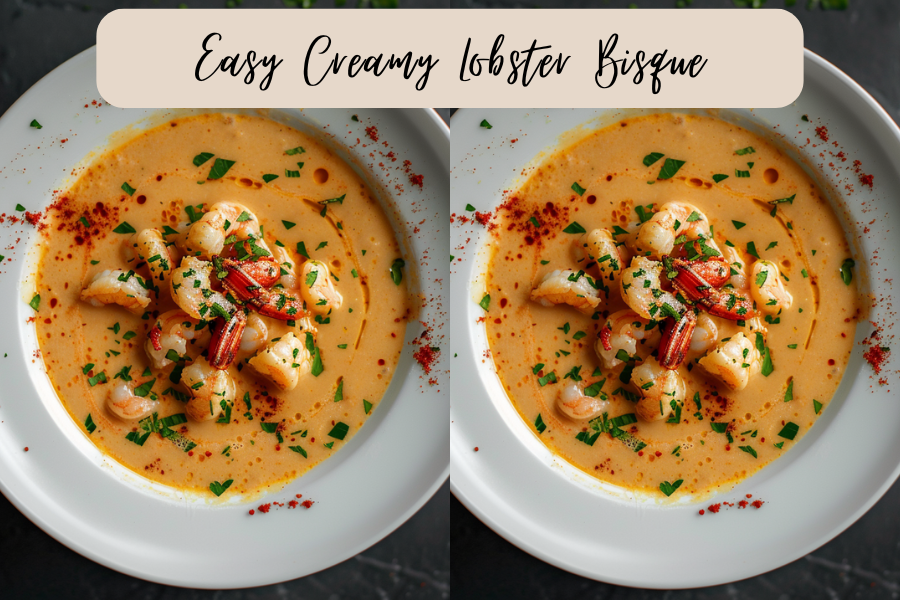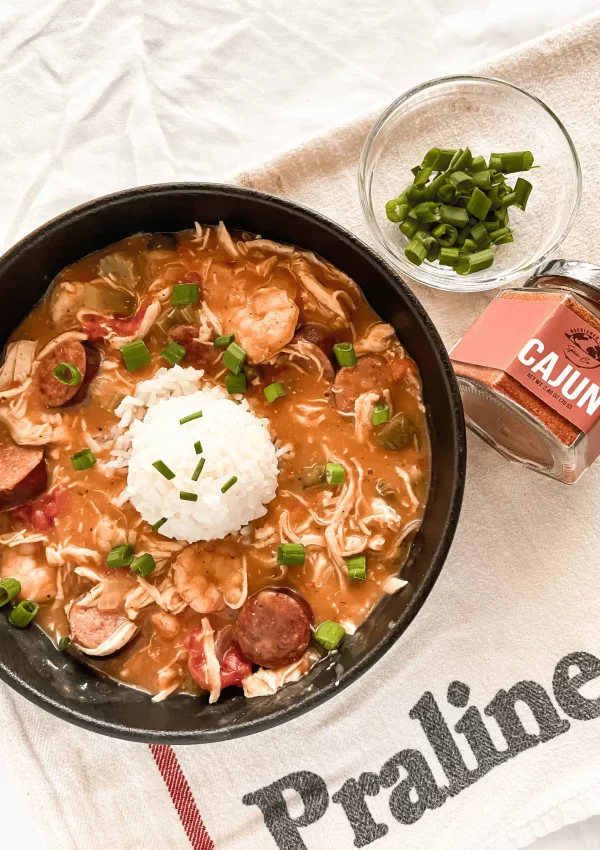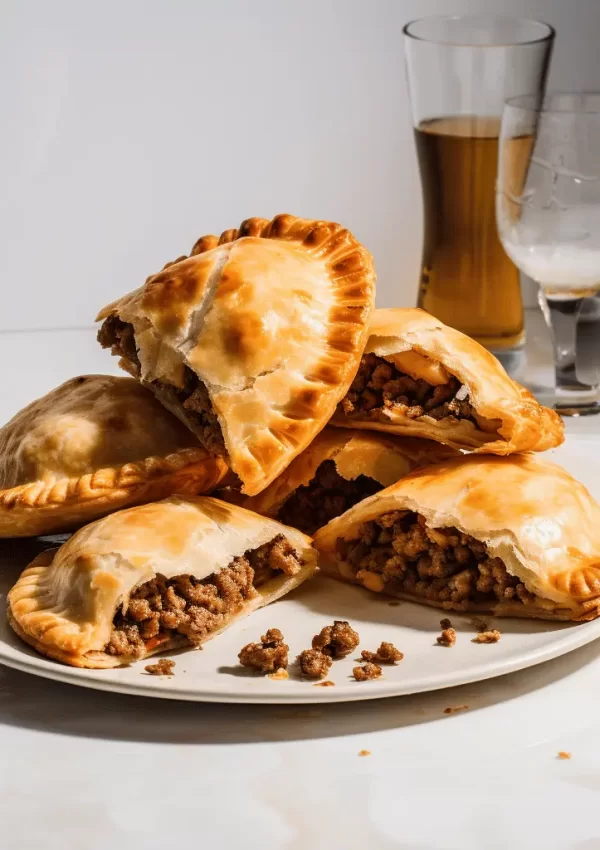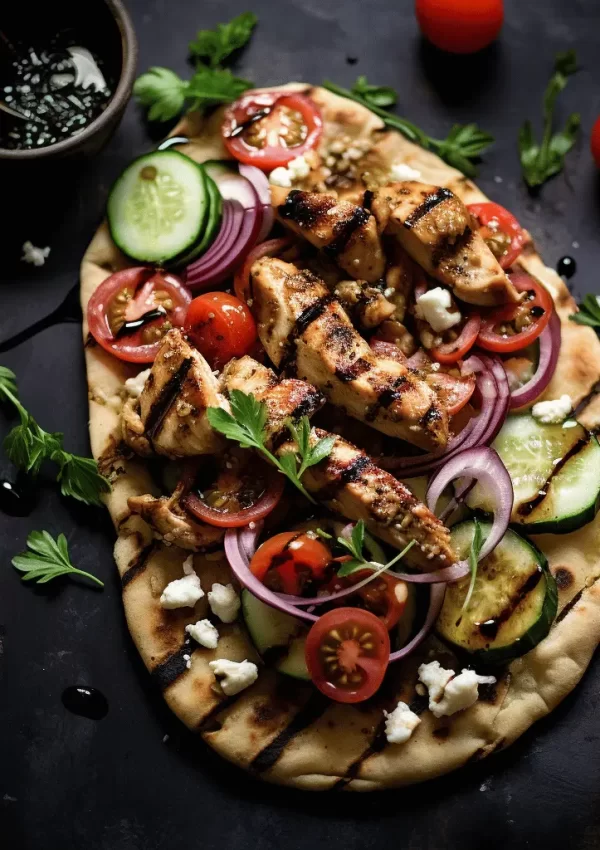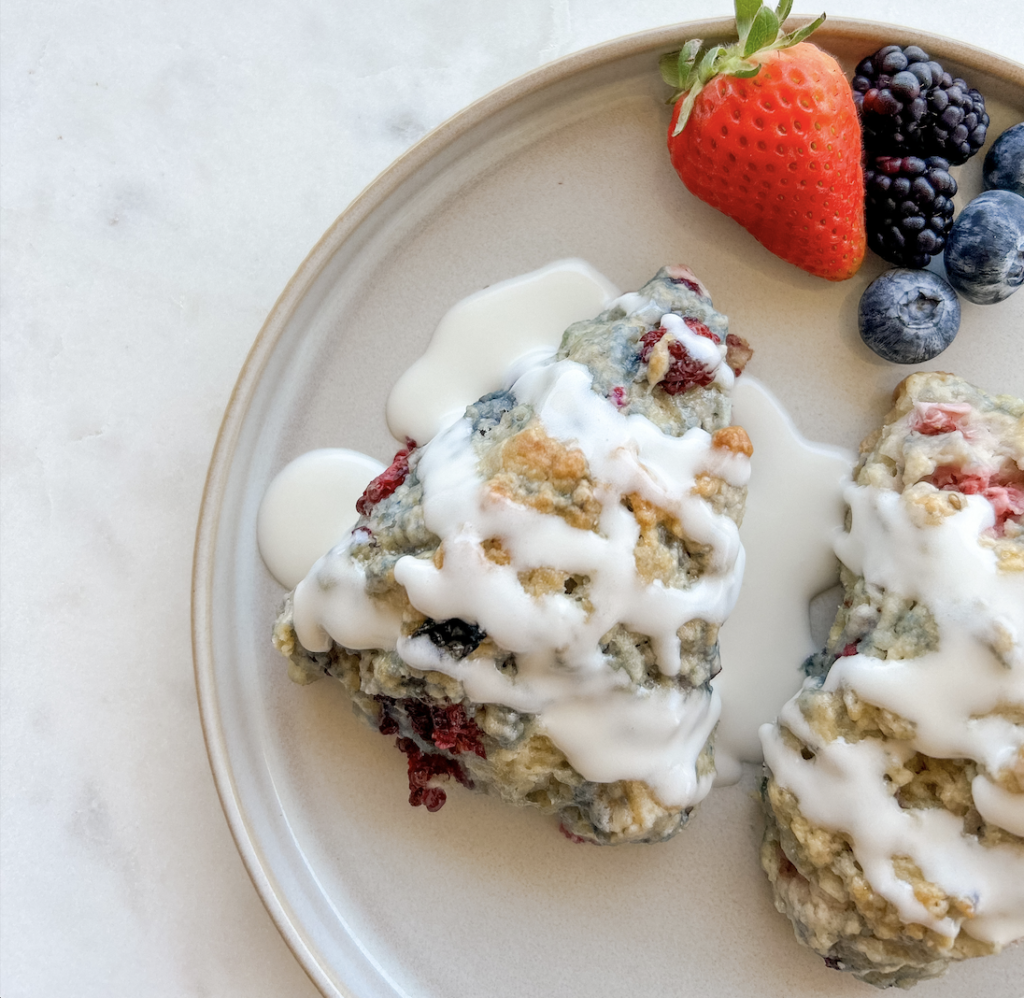This lobster bisque is creamy, delicious, and sure to impress your family or dinner guests! The best part – it’s quite simple to make!!
This post contains affiliate links, which means I’ll receive a commission if you purchase through my link, at no extra cost to you. Please read the full disclosure here.
I was born and raised in New Orleans, where we are no strangers to a good bisque. Typically, we serve corn & crab bisque or crawfish bisque. Corn and crab bisque is one of my favorite items to order when at an authentic New Orleans restaurant, but I’ve never worked up the confidence to attempt to make a homemade bisque until today!
I decided to try a lobster bisque because I found some lobster tails at my local Aldi this week – and it inspired me to make something with lobster! If you have never worked with lobster before – never fear! This was my first time making homemade lobster anything – but I used a shortcut. And today, I will let you in on my secret and give you a few options to try!
This recipe uses my BRAND NEW spice blend – my FRENCH blend! My new French blend is a lavender twist on Herbs de Provence – that’s right – it’s got lavender in it! I just got my first batch of French a few weeks ago and have only sold it at my local pop-up events. But (drum-roll please…) this blend is now available on our online shop! Click here to be one of the first lucky owners of our newest product!
This post is all about Lobster Bisque!
Lobster Options
So, I mentioned that I used a shortcut. My secret was that I used frozen, pre-cooked lobster tails. Specifically, I used frozen, pre-cooked Chilean lobsters called langostino! They looked like large crawfish tails, which is what drew me to them. Honestly, this was the first time I had ever heard of langostino lobster. But since they were small and pre-cooked, they couldn’t have been easier to work with!
What is Langostino Lobster?
The Langostino (also called ‘squat lobster’) are small crustaceans that resemble tiny lobsters, with tails generally measuring less than three inches long. They are commonly found in cold waters, particularly in the Pacific Ocean off the coast of Chile, where they are harvested for commercial purposes.
Langostinos are not true lobsters but are related to squat lobsters and hermit crabs. They have a sweet, delicate flavor similar to lobster, although some describe it as slightly milder. Langostinos are often used in seafood dishes like salads, pasta, and tacos, and they are typically sold cooked and peeled, making them convenient for various culinary applications. You can find langostinos in seafood markets, specialty grocery stores, and some restaurants, primarily in regions where they are harvested or imported. I got lucky finding them at Aldi for around $12 for 12 ounces!
Using Frozen, Pre-cooked lobster
When working with frozen, pre-cooked lobster, the main thing you need to worry about is that the lobster is thawed out completely and warmed through before serving. Easy peasy lemon squeezy.
Using Frozen, raw lobster
The first order of business would be thawing the lobster in the fridge overnight or under running water in the sink. Next, you can toss the lobster in the bisque after blending and let the lobster pieces cook in the bisque to optimize flavor.
Using Fresh Lobster Tails
- Bring a large pot of salted water to a boil. Use enough water to fully submerge the lobster tails.
- Using kitchen shears, cut along the top of each lobster tail shell, stopping at the tail fan.
- Carefully pull the shell apart and lift out the meat, leaving it attached at the base of the tail.
- Once the water is boiling, carefully add the lobster tails to the pot.
- Allow the lobster tails to boil for 1 minute per ounce of tail. For example, if the tail weighs 4 ounces, boil for about 4 minutes.
- While the lobster tails are boiling, prepare an ice bath in a large bowl.
- After the boiling time is up, use tongs to remove the lobster tails from the pot and immediately transfer them to the ice bath to stop the cooking process.
- Let the lobster tails cool in the ice bath for a few minutes, then remove and drain them.
- For this recipe, you can then chop the tails into smaller chunks to add back into the bisque after the bisque is blended. Leave them to simmer on low in the bisque for 2-3 minutes or until just warmed through (avoid overcooking).
Safe Internal Temperature For Lobster
The safe internal temperature for cooked lobster is 145°F. It’s essential to ensure that lobster meat is thoroughly cooked to this temperature to kill any harmful bacteria and ensure food safety. When measuring the temperature, insert a food thermometer into the thickest part of the lobster meat.
[the_ad id=”3378″]
Equipment Needs
Dutch Oven
I recommend using a Dutch oven for this recipe! It’s not required – any pot you have will do. But I like the sturdiness of a Dutch oven when I am blending a soup in the pot. Click here to shop the Dutch oven I use and recommend!
IMMERSION BLENDER
I highly recommend investing in an immersion blender if you plan to make blended soups. An immersion blender allows you to skip the messy step of ladling your soup into a blender in batches. The batches can be tedious and very messy. Plus, you have to factor in cooling time before blending. An immersion blender allows you to blend your soup directly in the pot it was prepared in! You will use it more than you think! Click here to shop the 5-in-1 hand blender set that I recommend. It comes with other handy tools like a small food processor, whisk, and milk frother! Pro Tip: using an immersion blender means fewer dishes! WIN!
You May Also Like
If you like this recipe, you may also be interested in:
OR click here to view the entire French category!
[the_ad id=”3378″]
Store & Reheat
As a general rule of thumb, bisques store and reheat well. That’s another reason I love this recipe!
Store
Fridge: Transfer the dish to a large glass storage container with an airtight lid. Allow it to cool to room temperature before securing the lid (about 30-45 minutes; the exact time depends on the amount of food). Store in the fridge for up to 4 days.
Freezer: You can also freeze the bisque for up to 3 months. Place the bisque in the fridge to thaw overnight for best results.
Reheat
Microwave: Place bisque in a microwave-safe dish, cover, and microwave on high for 1-3 minutes or until heated through. If reheating larger amounts, stir halfway through to warm it evenly.*
Stovetop: Place bisque in a pot over medium-high heat. Once the soup is simmering, reduce to medium-low and cover for 3-5 minutes or until heated through. Stir occasionally.*
Oven: Not recommended.
* Total time depends on the amount you are reheating.
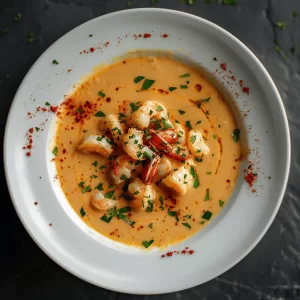
Easy Creamy Lobster Bisque
Ingredients
- 1/4 cup butter
- 1 onion, sliced
- 4 stalks celery, roughly chopped
- 3 large carrots, peeled and roughly chopped
- 4 cloves garlic, roughly chopped
- 1 14-oz can fire-roasted tomatoes
- 1 tsp The Spice Girl Kitchen French Blend OR Italian Seasoning
- 1 1/2 cups dry white wine
- salt & pepper, to taste
- 3 cups water or veggie broth
- 12 oz frozen, pre-cooked lobster tails, thawed
- 1 cup heavy cream
- green onion or parsley, for garnish
Instructions
- In a large pot or Dutch oven, melt the butter over medium heat.
- Add the onion, celery, and carrots. Let cook for about 10 minutes. Stirring occasionally.
- Add the garlic and cook for 1 additional minute.
- Add the fire-roasted tomatoes, french seasoning, white wine, salt, and pepper. Let simmer for 3-5 minutes or until wine is slightly reduced.
- Add the water, cover, and simmer for 20 minutes.
- Using a blender or an immersion blender, blend the soup until smooth.
- Add the thawed lobster tails and let simmer for 2-3 minutes or until warmed through. Stir in the heavy cream.
- Divide into bowls, garnish with green onion or parsley, and serve with bread. Enjoy!
Notes
What is Langostino Lobster?
The Langostino (also called 'squat lobster') are small crustaceans that resemble tiny lobsters, with tails generally measuring less than three inches long. They are commonly found in cold waters, particularly in the Pacific Ocean off the coast of Chile, where they are harvested for commercial purposes. Langostinos are not true lobsters but are related to squat lobsters and hermit crabs. They have a sweet, delicate flavor similar to lobster, although some describe it as slightly milder. Langostinos are often used in seafood dishes like salads, pasta, and tacos, and they are typically sold cooked and peeled, making them convenient for various culinary applications. You can find langostinos in seafood markets, specialty grocery stores, and some restaurants, primarily in regions where they are harvested or imported. I think I just got lucky finding them at Aldi for around $12 for 12 ounces!Using Frozen, Pre-cooked lobster
When working with frozen, pre-cooked lobster, the main thing you need to worry about is that the lobster is thawed out completely and warmed through before serving. Easy peasy lemon squeezy.Using Frozen, raw lobster
The first order of business would be thawing the lobster in the fridge overnight or under running water in the sink. Next, you can toss the lobster in the bisque after blending and let the lobster pieces cook in the bisque to optimize flavor.Using Fresh Lobster Tails
- Bring a large pot of salted water to a boil. Use enough water to fully submerge the lobster tails.
- Using kitchen shears, cut along the top of each lobster tail shell, stopping at the tail fan.
- Carefully pull the shell apart and lift out the meat, leaving it attached at the base of the tail.
- Once the water is boiling, carefully add the lobster tails to the pot.
- Allow the lobster tails to boil for 1 minute per ounce of tail. For example, if the tail weighs 4 ounces, boil for about 4 minutes.
- While the lobster tails are boiling, prepare an ice bath in a large bowl.
- After the boiling time is up, use tongs to remove the lobster tails from the pot and immediately transfer them to the ice bath to stop the cooking process.
- Let the lobster tails cool in the ice bath for a few minutes, then remove and drain them.
- For this recipe, you can then chop the tails into smaller chunks to add back into the bisque after the bisque is blended. Leave them to simmer on low in the bisque for 2-3 minutes or until just warmed through (avoid overcooking).
Safe Internal Temperature For Lobster
The safe internal temperature for cooked lobster is 145°F. It's essential to ensure that lobster meat is thoroughly cooked to this temperature to kill any harmful bacteria and ensure food safety. When measuring the temperature, insert a food thermometer into the thickest part of the lobster meat.This post was all about Lobster Bisque.
Did you make this recipe? Make sure to tag me @thespicegirlkitchen_ on Instagram or @thespicegirlkitchen on TikTok! I love seeing your recreations! I will be your ultimate hype woman!
Want to learn more about Kelsey? Click here to read her story!

